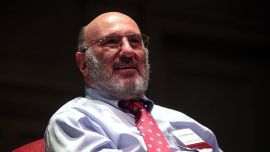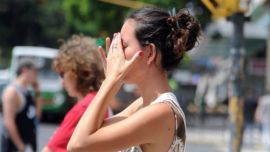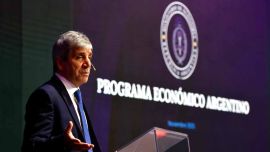Since this series began on April 8, its focus has been the national electoral panorama, the multiple provincial elections until now and (far less often) local voting with two of the above three occasionally sharing the spotlight but never all three levels of government at the same time. But between the final PASO primary count released at the end of August (just as last Saturday’s column was being concluded), tomorrow’s elections in the major province of Santa Fe and a batch of inland local results last weekend, today’s analysis will be looking at all three in a top down sequence.
For almost the first time this column’s forecast was borne out by the final results in the case of the PASO primary with the prediction that Javier Milei’s libertarian vote would fall below the psychologically important 30 percent mark (on the basis of 32.7 percent with 61 percent of the tally falling to 30.04 percent when the provisional counting was halted at 97 percent) and sure enough his final total was 29.86 percent. This was predictable enough, given that the slowest count was in Buenos Aires Province with not only its massive electorate (three out of every eight voters) but also the only district other than Santa Cruz to vote at every possible level, including the gubernatorial and senatorial. The BA Province factor also served to shrink the difference between the two main coalitions from one to 0.7 percent (with 28 and 27.28 percent the final figures for Juntos por el Cambio and Unión por la Patria respectively). The overall gap between the three main tickets also fell slightly from 2.77 to 2.58 percent.
Anyway the final PASO results are more than a week old so there seems more point in looking at how they project into the future rather than digging deeper into details. The primary reduced the field to five presidential candidates for the October general elections – Milei for La Libertad Avanza (29.86 percent), Economy Minister Sergio Massa for Unión por la Patria (21.43 percent), Patricia Bullrich for Juntos por el Cambio (16.81 percent), Córdoba Governor Juan Schiaretti for Hacemos por Nuestro País (3.71 percent) and Myriam Bregman for Frente de Izquierda y de los Trabajadores-Unidad (1.94 percent). These add up to 73.75 percent of the valid votes with their eliminated internal and external rivals claiming more than a quarter. But the valid votes (23,269,294) were less than two-thirds of an electorate totalling 35,394,425 citizens –blank votes (5.51 percent), spoiled ballots (1.24 percent) and those who simply did not vote add up to over 12 million. The bottom line thus leaves the quintet of surviving presidential candidates with little more than half the electorate (18,135,435 of the 35,294,425, to be exact) and the three leading candidates less than half (16,769,348 on an individual basis).
This three-way split with half the electorate potentially up for grabs opens up infinite mathematical possibilities – the ultimate result is thus vulnerable to circumstance and strategy much further down the road. A glance at more qualitative factors ahead of moving to Santa Fe but before giving the number-crunching a rest, it might be pointed out that the three-way split was almost nationwide – only one absolute majority in the whole country (Santiago del Estero for Massa) and only six districts where anybody even reached 40 percent (four for Milei, Formosa for Massa and this city for Bullrich).
The national campaign panorama will dominate this column far more next month once the trio of provincial elections in the last three Sundays of this month (Santa Fe, Chaco and Mendoza) is over and the real elections are around the corner. The most summary of the summaries here belongs to Massa. If “it’s the economy, stupid” in the phrase famously coined by James Carville and if the government candidate is the economy minister no less, what more remains to be said? Clearly a hostage to (mis)fortune.
Not much more to be said about Milei, especially if it would be premature ahead of his encounter with Tucker Carlson looming as this column was being written. Not that this interview is likely to either gain or lose votes for Milei, no matter how brilliant or outrageous it might be, and this indeed seems to be the story of his support – he can neither do anything right as still an outsider nor say anything wrong, no matter how much he shoots his mouth. His supporters continue to defy definition – each of them has their own Milei. “In the jungle, the mighty jungle, the lion sleeps tonight” would seem to describe both today’s economy and the current stage of the Milei campaign.
The logical choice among this trio in a rational world, Bullrich is currently trailing against Milei for much the same reasons enabling her to top City Mayor Horacio Rodriguez Larreta in last month’s primary. She bested the latter’s machine largely through sheer personality but faced with competing with Milei’s one-man show or contrasting it with teamwork, she has sacrificed her prime asset by opting for the latter in the person of Carlos Meclonian as her economic voice. Apart from being potentially overshadowed as much as complemented by the latter, she is complicated by the presence or absence of ex-president Mauricio Macri alike – a presence might make her seem a puppet while an absence would arouse suspicions that Macri is weaving a new alliance with Milei. Bullrich’s problems have even aroused the anxieties of Massa that if she falls any further, she could rob him of his run-off chances by giving Milei the double-digit lead needed to win the first round if reaching 40 percent.
Not much space left for tomorrow’s Santa Fe provincial elections but they are generally considered to have been defined in advance by the July 16 primary when Juntos por el Cambio swept almost two-thirds of the vote, of which well over half went to their Radical gubernatorial candidate Maximiliano Pullaro. That was July but the most recent opinion polls are giving Pullaro a 20-point lead over Peronist Senator Marcelo Lewandowski – if the pollsters can be that wrong, all the more reason to wait for the actual results. The closest candidate to Milei, Edelvino Bodoira (perhaps sharing a pro-life stance more than a libertarian ideology), is only given several percent by the polls and Trotskyist Carla Deiana a couple of points – they are the only other candidates since Eduardo Maradona of Elisa Carrió’s Civic Coalition also cleared the 1.5 percent primary threshold but is not on the ballot. Much more on Santa Fe next week with the hard data to analyse.
Last and perhaps least but also serving to make a couple of valid points, the latest municipal voting. Firstly, the Río Negro tourist centre of Bariloche. Outgoing governor Arabela Carreras helped her Juntos Somos Río Negro party to retain the province by a comfortable 20-point margin last April and yet her mayoral bid last Sunday was spurned by the Bariloche voters – an example of the vagaries of electoral fortunes. As was the municipal voting in Mendoza last weekend, also showing the huge differences in national, provincial and local elections. Only three weekends previously Massa had garnered just 16.9 percent in Mendoza in the PASO primary (only Córdoba was worse) – last Sunday the Peronists swept six of the seven communes at stake with an absolute majority in all of them (except for 49 percent in San Rafael, the only city to vote last weekend with a six-digit electorate other than Bariloche).
Next weekend a postscript on Santa Fe and a preview of Chaco.























Comments